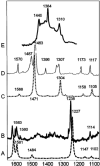Suppression of humoral immune responses by 2,3,7,8-tetrachlorodibenzo-p-dioxin intercalated in smectite clay
- PMID: 21994089
- PMCID: PMC5896024
- DOI: 10.1002/etc.701
Suppression of humoral immune responses by 2,3,7,8-tetrachlorodibenzo-p-dioxin intercalated in smectite clay
Abstract
2,3,7,8-Tetrachlorodibenzo-p-dioxin (TCDD) is a highly toxic environmental contaminant found in soils and sediments. Because of its exceptionally low water solubility, this compound exists predominantly in the sorbed state in natural environments. Clay minerals, especially expandable smectite clays, are one of the major component geosorbents in soils and sediments that can function as an effective adsorbent for environmental dioxins, including TCDD. In this study, TCDD was intercalated in the smectite clay saponite by an incipient wetness method. The primary goal of this study was to intercalate TCDD in natural K-saponite clay and evaluate its immunotoxic effects in vivo. The relative bioavailability of TCDD was evaluated by comparing the metabolic activity of TCDD administered in the adsorbed state as an intercalate in saponite and freely dissolved in corn oil. This comparison revealed nearly identical TCDD-induced suppression of humoral immunity, a well-established and sensitive sequela, in a mammalian (mouse) model. This result suggests that TCDD adsorbed by clays is likely to be available for biouptake and biodistribution in mammals, consistent with previous observations of TCDD in livestock exposed to dioxin-contaminated ball clays that were used as feed additives. Adsorption of TCDD by clay minerals does not appear to mitigate risk associated with TCDD exposure substantially.
Copyright © 2011 SETAC.
Figures







Similar articles
-
Natural organic matter does not diminish the mammalian bioavailability of 2,3,7,8-tetrachlorodibenzo-p-dioxin.Chemosphere. 2021 Feb;264(Pt 1):128420. doi: 10.1016/j.chemosphere.2020.128420. Epub 2020 Sep 23. Chemosphere. 2021. PMID: 33032214 Free PMC article.
-
Sequestration of 2,3,7,8-tetrachlorodibenzo-p-dioxin by activated carbon eliminates bioavailability and the suppression of immune function in mice.Environ Toxicol Chem. 2017 Oct;36(10):2671-2678. doi: 10.1002/etc.3815. Epub 2017 Jun 15. Environ Toxicol Chem. 2017. PMID: 28370362 Free PMC article.
-
TCDD adsorbed on silica as a model for TCDD contaminated soils: Evidence for suppression of humoral immunity in mice.Toxicology. 2011 Apr 11;282(3):82-7. doi: 10.1016/j.tox.2011.01.013. Epub 2011 Jan 25. Toxicology. 2011. PMID: 21272611 Free PMC article.
-
The long winding road toward understanding the molecular mechanisms for B-cell suppression by 2,3,7,8-tetrachlorodibenzo-p-dioxin.Toxicol Sci. 2011 Mar;120 Suppl 1(Suppl 1):S171-91. doi: 10.1093/toxsci/kfq324. Epub 2010 Oct 15. Toxicol Sci. 2011. PMID: 20952503 Free PMC article. Review.
-
Evaluation of potential transmission of 2,3,7,8-tetrachlorodibenzo-p-dioxin-contaminated incinerator emissions to humans via foods.J Toxicol Environ Health. 1990;29(1):1-43. doi: 10.1080/15287399009531369. J Toxicol Environ Health. 1990. PMID: 2405173 Review.
Cited by
-
Synthesis and evaluation of Fe3O4-impregnated activated carbon for dioxin removal.Chemosphere. 2021 Jan;263:128263. doi: 10.1016/j.chemosphere.2020.128263. Epub 2020 Sep 6. Chemosphere. 2021. PMID: 33297207 Free PMC article.
-
Natural organic matter does not diminish the mammalian bioavailability of 2,3,7,8-tetrachlorodibenzo-p-dioxin.Chemosphere. 2021 Feb;264(Pt 1):128420. doi: 10.1016/j.chemosphere.2020.128420. Epub 2020 Sep 23. Chemosphere. 2021. PMID: 33032214 Free PMC article.
-
TCDD administered on activated carbon eliminates bioavailability and subsequent shifts to a key murine gut commensal.Appl Microbiol Biotechnol. 2017 Oct;101(19):7409-7415. doi: 10.1007/s00253-017-8460-9. Epub 2017 Aug 15. Appl Microbiol Biotechnol. 2017. PMID: 28812142 Free PMC article.
-
Alternatives to antibiotics for sustainable livestock production in the context of the One Health approach: tackling a common foe.Front Vet Sci. 2025 Aug 13;12:1605215. doi: 10.3389/fvets.2025.1605215. eCollection 2025. Front Vet Sci. 2025. PMID: 40881639 Free PMC article. Review.
-
Sequestration of 2,3,7,8-tetrachlorodibenzo-p-dioxin by activated carbon eliminates bioavailability and the suppression of immune function in mice.Environ Toxicol Chem. 2017 Oct;36(10):2671-2678. doi: 10.1002/etc.3815. Epub 2017 Jun 15. Environ Toxicol Chem. 2017. PMID: 28370362 Free PMC article.
References
-
- Liu C, Li H, Teppen BJ, Johnston CT, Boyd SA. Mechanisms associated with the high adsorption of dibenzo-p-dioxin from water by smectite clays. Environ Sci Technol. 2009;43:2777–2783. - PubMed
-
- Rana K, Boyd SA, Teppen BJ, Li H, Liu C. Probing the microscopic hydrophobicity of smectite surfaces: A vibrational spectroscopic study of dibenzo-p-dioxin sorption to smectite. Physical Chem Chem Physics. 2009;11:2976–2985. - PubMed
-
- Ferrario J, Byrne C. Dibenzo-p-dioxins in the environment from ceramics and pottery produced from ball clay mined in the United States. Chemosphere. 2002;46:1297–1301. - PubMed
-
- Ferrario J, Byrne C, Schaum J. Concentrations of polychlorinated dibenzo-p-dioxins in processed ball clay from the United States. Chemosphere. 2007;67:1816–1821. - PubMed
-
- Ferrario J, Byrne CJ, Cleverly DH. 2,3,7,8-Dibenzo-p-dioxins in mined clay products from the United States: Evidence for possible natural origin. Environ Sci Technol. 2000;34:4524–4532.
Publication types
MeSH terms
Substances
Grants and funding
LinkOut - more resources
Full Text Sources

